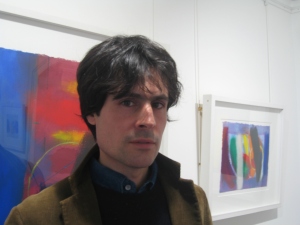For my last blog at StAnza, meditating on poetry inspired by landscape/art or vice versa, I went along to the exhibition, ‘Unmapped’ , also about the marginal. A beautiful collaboration of paintings by Anna King and poems by Rebecca Sharp, it is also available in book form. Paintings and poems are a conversation about places rarely noticed, the derelict, the leaking boundaries between past and present, absence and longing. ‘I love to explore empty feral places’ says Anna King, ‘where nature is slowly and relentlessly taking the land back.’
I loved how painter and poet echo each other: brush or maybe palette knife strokes are clearly visible in almost half-finished paintings, where the background shows through, just as in the poems the past haunts the present. Rebecca’s vocabulary echoes the painter’s techniques: ‘gouging’, ‘scratched’, ‘seeping through’ and ‘Ink from a stairwell/bleeds into a boy’.
This is poetry as psychogeography, strangely evocative when they hint at so much absence: ‘We were always somewhere else,/waiting to appear.’ Anna Crowe calls these ‘restless, shifting poems’ and you can read the full review and see more poems and pictures through the project website
http://unmapped-project.co.uk/, and press Book for pictures, and Work for poems.
Welsh poetry, past and present
It was sound career sense of Dylan (pron. Dullan, so you can show off you know this) Thomas to die a bohemian death in New York, said Robert Minhinnick at his Past & Present talk. It would not have had the same myth-making impact if he’d died in Swansea Hospital after a bender in a local pub. Recent research indicates that Dylan did not die so much of drink, as of a diabetic attack.
It is Dylan’s centenary next year so ‘Be afraid. Be very afraid’ warned Minhinnick. Personally, I can’t wait.
Lynette Roberts is not so well-known, of course. Born in Argentina, but moving to Wales on marriage, she was writing in the 30’s and 40’s and admired by T.S. Eliot as a fellow modernist. Sadly Roberts suffered from schizophrenia and wrote no more after the 50’s – perhaps explaining the diminishing of her reputation. Like Roberts, Zoë Skoulding‘s own poetry explores language as ‘soundings’, or ‘noise’ so her talk revealed her own interests too.
Deryn Rees-Jones, short-listed for the T.S. Eliot prize in 2012, gave a reading of her tour de force ‘Dog Woman’ a sequence inspired by Paula Rego’s paintings which were a highlight of the festival
Other highlights were Samantha Wynne-Rhydderch’s Antarctic poems and Eurig Salisbury, Welsh Children’s Laureate. ‘I like eggs for breakfast, especially omelettes,’ he said. He tells this to the kids he visits at school – it’s important they eat well (as well as enjoy poems).
These readings were a great note to end the festival on. Diolch yn fawr for having me.
Tipyn Bach of Welsh:
Hwyl Fawr (pron Hoo-ill vow-r) Goodbye. (Lit . Have great fun.) There is no Goodbye in Welsh – appropriate because we hope we’ll meet again at StAnza 2014.






















